Miele W 4449 WPS User Manual
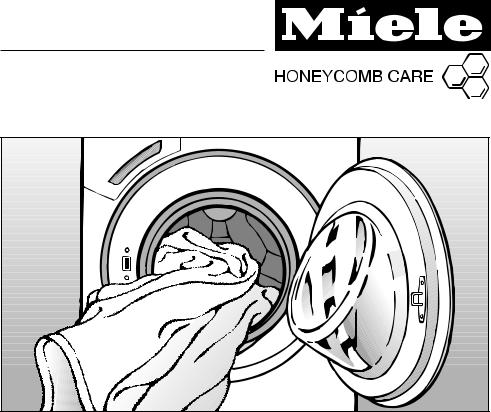
Operating instructions for Washing machine
W 4449 WPS LiquidWash
To avoid the risk of accidents or damage to the machine it is essential to read these instructions before it is installed and used for the first time.
G
M.-Nr. 06 732 380

Caring for our environment
Disposal of the packing material
The transport and protective packing has been selected from materials which are environmentally friendly for disposal and can normally be recycled.
Ensure that any plastic wrappings, bags etc. are disposed of safely and kept out of the reach of babies and young children. Danger of suffocation!
Rather than just throwing these materials away, please ensure they are offered for recycling.
Disposal of your old appliance or machine
Electrical and electronic appliances / machines often contain materials which, if handled or disposed of incorrectly, could be potentially hazardous to human health and to the environment. They are, however, essential for the correct functioning of your appliance or machine. Please do not therefore dispose of your old machine or appliance with your household waste.
Please dispose of it at your local community waste collection / recycling centre and ensure that it presents no danger to children while being stored for disposal.
It should be unplugged or disconnected from the mains electricity supply by a competent person. The plug must be rendered useless and the cable cut off directly behind it to prevent misuse. See the "Warning and Safety" section of this booklet for further details.
2

Contents
Caring for our environment. . . . . . . . . . . . . . . . . . . . . . . . . . . . . . . . . . . . . . . . . . 2 Disposal of the packing material . . . . . . . . . . . . . . . . . . . . . . . . . . . . . . . . . . . . . . . 2 Disposal of your old appliance or machine . . . . . . . . . . . . . . . . . . . . . . . . . . . . . . . 2
Warning and Safety instructions . . . . . . . . . . . . . . . . . . . . . . . . . . . . . . . . . . . . . 6
Operating the washing machine. . . . . . . . . . . . . . . . . . . . . . . . . . . . . . . . . . . . . 10 Control panel . . . . . . . . . . . . . . . . . . . . . . . . . . . . . . . . . . . . . . . . . . . . . . . . . . . . . 10 Display . . . . . . . . . . . . . . . . . . . . . . . . . . . . . . . . . . . . . . . . . . . . . . . . . . . . . . . . . . 11
Before using for the first time . . . . . . . . . . . . . . . . . . . . . . . . . . . . . . . . . . . . . . . 13 Preparing the washing machine . . . . . . . . . . . . . . . . . . . . . . . . . . . . . . . . . . . . . . 13 Priming the liquid detergent dispensing system . . . . . . . . . . . . . . . . . . . . . . . . . . 14
Liquid detergent dispensing. . . . . . . . . . . . . . . . . . . . . . . . . . . . . . . . . . . . . . . . 16 How automatic liquid detergent dispensing works . . . . . . . . . . . . . . . . . . . . . . . . 16 Dosage level . . . . . . . . . . . . . . . . . . . . . . . . . . . . . . . . . . . . . . . . . . . . . . . . . . . . . 16 Useful tips . . . . . . . . . . . . . . . . . . . . . . . . . . . . . . . . . . . . . . . . . . . . . . . . . . . . . . . 17
Washing environmentally and economically. . . . . . . . . . . . . . . . . . . . . . . . . . . 18 Energy and water consumption . . . . . . . . . . . . . . . . . . . . . . . . . . . . . . . . . . . . 18 Detergent . . . . . . . . . . . . . . . . . . . . . . . . . . . . . . . . . . . . . . . . . . . . . . . . . . . . . 18
How to wash correctly . . . . . . . . . . . . . . . . . . . . . . . . . . . . . . . . . . . . . . . . . . . . . 19
Extra options . . . . . . . . . . . . . . . . . . . . . . . . . . . . . . . . . . . . . . . . . . . . . . . . . . . . 25 Short. . . . . . . . . . . . . . . . . . . . . . . . . . . . . . . . . . . . . . . . . . . . . . . . . . . . . . . . . . . . 25 Water plus . . . . . . . . . . . . . . . . . . . . . . . . . . . . . . . . . . . . . . . . . . . . . . . . . . . . . . . 25 Pre-wash . . . . . . . . . . . . . . . . . . . . . . . . . . . . . . . . . . . . . . . . . . . . . . . . . . . . . . . . 25 Further extras. . . . . . . . . . . . . . . . . . . . . . . . . . . . . . . . . . . . . . . . . . . . . . . . . . . . . 25
Soak . . . . . . . . . . . . . . . . . . . . . . . . . . . . . . . . . . . . . . . . . . . . . . . . . . . . . . . . . 25 Rinse hold . . . . . . . . . . . . . . . . . . . . . . . . . . . . . . . . . . . . . . . . . . . . . . . . . . . . . 25 Extra rinse . . . . . . . . . . . . . . . . . . . . . . . . . . . . . . . . . . . . . . . . . . . . . . . . . . . . . 25 Buzzer . . . . . . . . . . . . . . . . . . . . . . . . . . . . . . . . . . . . . . . . . . . . . . . . . . . . . . . . . . 25
Spinning . . . . . . . . . . . . . . . . . . . . . . . . . . . . . . . . . . . . . . . . . . . . . . . . . . . . . . . . 26 Final spin speed . . . . . . . . . . . . . . . . . . . . . . . . . . . . . . . . . . . . . . . . . . . . . . . . . . 26 Rinse and interim spin . . . . . . . . . . . . . . . . . . . . . . . . . . . . . . . . . . . . . . . . . . . 26 To omit the final spin (Rinse hold). . . . . . . . . . . . . . . . . . . . . . . . . . . . . . . . . . . 26 To omit rinse and interim spin and the final spin (No spin). . . . . . . . . . . . . . . . 26
Delay start. . . . . . . . . . . . . . . . . . . . . . . . . . . . . . . . . . . . . . . . . . . . . . . . . . . . . . . 27
Programme chart . . . . . . . . . . . . . . . . . . . . . . . . . . . . . . . . . . . . . . . . . . . . . . . . . 29
Programme sequence . . . . . . . . . . . . . . . . . . . . . . . . . . . . . . . . . . . . . . . . . . . . . 33
Garment care label symbols . . . . . . . . . . . . . . . . . . . . . . . . . . . . . . . . . . . . . . . . 35
3

Contents
Changing the programme sequence . . . . . . . . . . . . . . . . . . . . . . . . . . . . . . . . . 36 Cancelling a programme . . . . . . . . . . . . . . . . . . . . . . . . . . . . . . . . . . . . . . . . . . . . 36 Interrupting a programme . . . . . . . . . . . . . . . . . . . . . . . . . . . . . . . . . . . . . . . . . . . 36 Changing a programme. . . . . . . . . . . . . . . . . . . . . . . . . . . . . . . . . . . . . . . . . . . . . 36 Adding or removing laundry after a programme has started . . . . . . . . . . . . . . . . 37 Safety lock . . . . . . . . . . . . . . . . . . . . . . . . . . . . . . . . . . . . . . . . . . . . . . . . . . . . . . . 37
Detergent . . . . . . . . . . . . . . . . . . . . . . . . . . . . . . . . . . . . . . . . . . . . . . . . . . . . . . . 38 The correct detergent . . . . . . . . . . . . . . . . . . . . . . . . . . . . . . . . . . . . . . . . . . . . . . 38 Water softeners. . . . . . . . . . . . . . . . . . . . . . . . . . . . . . . . . . . . . . . . . . . . . . . . . 39 Washing with several components . . . . . . . . . . . . . . . . . . . . . . . . . . . . . . . . . . 39 Fabric conditioners and liquid starch . . . . . . . . . . . . . . . . . . . . . . . . . . . . . . . . 40 Colour run and dye removers/dyes . . . . . . . . . . . . . . . . . . . . . . . . . . . . . . . . . 40
Cleaning and care . . . . . . . . . . . . . . . . . . . . . . . . . . . . . . . . . . . . . . . . . . . . . . . . 41 External casing and fascia panel . . . . . . . . . . . . . . . . . . . . . . . . . . . . . . . . . . . . . 41 E-Cloth . . . . . . . . . . . . . . . . . . . . . . . . . . . . . . . . . . . . . . . . . . . . . . . . . . . . . . . 41 Extra cleaning . . . . . . . . . . . . . . . . . . . . . . . . . . . . . . . . . . . . . . . . . . . . . . . . . . 41 Cleaning the detergent dispenser drawer. . . . . . . . . . . . . . . . . . . . . . . . . . . . . . . 41 Cleaning the siphon and conditioner channel . . . . . . . . . . . . . . . . . . . . . . . . . 42 Cleaning the dispensing unit . . . . . . . . . . . . . . . . . . . . . . . . . . . . . . . . . . . . . . . . . 43 Cleaning the container and lid . . . . . . . . . . . . . . . . . . . . . . . . . . . . . . . . . . . . . 43 Cleaning the dispensing tube. . . . . . . . . . . . . . . . . . . . . . . . . . . . . . . . . . . . . . 43 Cleaning the filter in the water inlet . . . . . . . . . . . . . . . . . . . . . . . . . . . . . . . . . . . . 44
Problem solving guide. . . . . . . . . . . . . . . . . . . . . . . . . . . . . . . . . . . . . . . . . . . . . 45 The programme does not start . . . . . . . . . . . . . . . . . . . . . . . . . . . . . . . . . . . . . . . 45 Fault messages in the display . . . . . . . . . . . . . . . . . . . . . . . . . . . . . . . . . . . . . . . . 46 Problems with the automatic liquid detergent dispensing system . . . . . . . . . . . . 47 General problems . . . . . . . . . . . . . . . . . . . . . . . . . . . . . . . . . . . . . . . . . . . . . . . . . 49 An unsatisfactory wash result . . . . . . . . . . . . . . . . . . . . . . . . . . . . . . . . . . . . . . . . 50 The door will not open . . . . . . . . . . . . . . . . . . . . . . . . . . . . . . . . . . . . . . . . . . . . . . 51 Opening the drum door in the event of a blocked drain outlet and/or
power failure . . . . . . . . . . . . . . . . . . . . . . . . . . . . . . . . . . . . . . . . . . . . . . . . . . . . . 52 Blocked drain outlet . . . . . . . . . . . . . . . . . . . . . . . . . . . . . . . . . . . . . . . . . . . . . 52
After sales service . . . . . . . . . . . . . . . . . . . . . . . . . . . . . . . . . . . . . . . . . . . . . . . . 54 Repairs . . . . . . . . . . . . . . . . . . . . . . . . . . . . . . . . . . . . . . . . . . . . . . . . . . . . . . . 54 Future updates (PC) . . . . . . . . . . . . . . . . . . . . . . . . . . . . . . . . . . . . . . . . . . . . . 54 Appliance guarantee . . . . . . . . . . . . . . . . . . . . . . . . . . . . . . . . . . . . . . . . . . . . 54 Optional accessories . . . . . . . . . . . . . . . . . . . . . . . . . . . . . . . . . . . . . . . . . . . . 54
4

Contents
Installation and connection . . . . . . . . . . . . . . . . . . . . . . . . . . . . . . . . . . . . . . . . 55 Front view. . . . . . . . . . . . . . . . . . . . . . . . . . . . . . . . . . . . . . . . . . . . . . . . . . . . . . . . 55 Rear view . . . . . . . . . . . . . . . . . . . . . . . . . . . . . . . . . . . . . . . . . . . . . . . . . . . . . . . . 56 Installation surface. . . . . . . . . . . . . . . . . . . . . . . . . . . . . . . . . . . . . . . . . . . . . . . . . 57 Transporting the machine to its installation site . . . . . . . . . . . . . . . . . . . . . . . . 57 Removing the transit fittings . . . . . . . . . . . . . . . . . . . . . . . . . . . . . . . . . . . . . . . . . 57 Re-fitting the transit bars . . . . . . . . . . . . . . . . . . . . . . . . . . . . . . . . . . . . . . . . . . . . 59 Levelling the machine . . . . . . . . . . . . . . . . . . . . . . . . . . . . . . . . . . . . . . . . . . . . . . 60 Dispensing unit . . . . . . . . . . . . . . . . . . . . . . . . . . . . . . . . . . . . . . . . . . . . . . . . . . . 61 The Miele Waterproof system . . . . . . . . . . . . . . . . . . . . . . . . . . . . . . . . . . . . . . . . 64 Connection to the water supply . . . . . . . . . . . . . . . . . . . . . . . . . . . . . . . . . . . . . . . 65 Connection to the drainage system. . . . . . . . . . . . . . . . . . . . . . . . . . . . . . . . . . . . 67 Electrical connection U.K. . . . . . . . . . . . . . . . . . . . . . . . . . . . . . . . . . . . . . . . . . . . 68
Consumption data . . . . . . . . . . . . . . . . . . . . . . . . . . . . . . . . . . . . . . . . . . . . . . . . 69 Notes for test institutes: . . . . . . . . . . . . . . . . . . . . . . . . . . . . . . . . . . . . . . . . . . 69
Technical data . . . . . . . . . . . . . . . . . . . . . . . . . . . . . . . . . . . . . . . . . . . . . . . . . . . 70
Settings menu . . . . . . . . . . . . . . . . . . . . . . . . . . . . . . . . . . . . . . . . . . . . . . . . . . . 72 To open the Settings menu . . . . . . . . . . . . . . . . . . . . . . . . . . . . . . . . . . . . . . . . 72 Language F. . . . . . . . . . . . . . . . . . . . . . . . . . . . . . . . . . . . . . . . . . . . . . . . . . . . . . 72 Time (of day) . . . . . . . . . . . . . . . . . . . . . . . . . . . . . . . . . . . . . . . . . . . . . . . . . . . . . 72 Detergent dosage . . . . . . . . . . . . . . . . . . . . . . . . . . . . . . . . . . . . . . . . . . . . . . . . . 73 Gentle action . . . . . . . . . . . . . . . . . . . . . . . . . . . . . . . . . . . . . . . . . . . . . . . . . . . . . 73 Longer pre-wash . . . . . . . . . . . . . . . . . . . . . . . . . . . . . . . . . . . . . . . . . . . . . . . . . . 73 Suds cooling . . . . . . . . . . . . . . . . . . . . . . . . . . . . . . . . . . . . . . . . . . . . . . . . . . . . . 73 Lock code . . . . . . . . . . . . . . . . . . . . . . . . . . . . . . . . . . . . . . . . . . . . . . . . . . . . . . . 74 Temperature unit . . . . . . . . . . . . . . . . . . . . . . . . . . . . . . . . . . . . . . . . . . . . . . . . . . 75 Buzzer . . . . . . . . . . . . . . . . . . . . . . . . . . . . . . . . . . . . . . . . . . . . . . . . . . . . . . . . . . 75 Keypad tone . . . . . . . . . . . . . . . . . . . . . . . . . . . . . . . . . . . . . . . . . . . . . . . . . . . . . 75 Brightness . . . . . . . . . . . . . . . . . . . . . . . . . . . . . . . . . . . . . . . . . . . . . . . . . . . . . . . 75 Contrast . . . . . . . . . . . . . . . . . . . . . . . . . . . . . . . . . . . . . . . . . . . . . . . . . . . . . . . . . 75 Standby . . . . . . . . . . . . . . . . . . . . . . . . . . . . . . . . . . . . . . . . . . . . . . . . . . . . . . . . . 76 Memory . . . . . . . . . . . . . . . . . . . . . . . . . . . . . . . . . . . . . . . . . . . . . . . . . . . . . . . . . 76
5

Warning and Safety instructions
To avoid the risk of accidents and damage to the machine please read these instructions carefully before using it for the first time. They contain important information on its safety, use and maintenance.
Keep these instructions in a safe place and ensure that new users are familiar with the content. Pass them on to any future owner of the machine.
Correct usage
Only use the washing machine to wash items which are specified by
the manufacturer to be machine-washable on the wash-care label, and textiles composed of hand-washable wool or wool blend fabrics as well as satin, lace, silk and other hand-washable garments. Any other applications may be dangerous. The manufacturer is not liable for damage resulting from improper use or operation.
Technical safety
Before setting up the machine, check it for any externally visible
damage.
Do not install or use a damaged machine.
Before connecting the machine, ensure that the connection data on
the data plate match the mains electricity supply. If in any doubt, consult a qualified electrician.
The electrical safety of this machine can only be guaranteed
when continuity is complete between the machine and an effective earthing system which complies with local and national safety regulations. It is most important that this basic safety requirement is present and regularly tested, and where there is any doubt the household wiring system should be inspected by a qualified electrician. The manufacturer cannot be held liable for the consequences of an inadequate earthing system (e.g. electric shock).
Do not connect the machine to the mains electricity supply by an
extension lead. Extension leads do not guarantee the required safety of the machine (e.g. danger of overheating).
The machine is built in accordance with current safety requirements.
Unauthorised repairs could result in unforeseen dangers for the user, for which the manufacturer cannot accept liability. Repairs should only be undertaken by a Miele approved technician.
Ensure current is not supplied to the machine until after maintenance or repair work has been carried out.
6

Warning and Safety instructions
The machine is only completely isolated from the electricity supply
when:
–it is switched off at the wall socket and the plug is withdrawn, or
–it is switched off at the mains, or
–the mains fuse is disconnected, or
–the screw-out fuse is removed (in countries where this is applicable).
The Miele "Water protection system" protects from water damage provided the following
conditions have been met:
–the machine is correctly plumbed in and connected to the electricity supply.
–if a fault has been identified, the machine must be examined by a competent person before further use, and repaired if necessary.
Faulty components must only be replaced by genuine Miele original
spare parts. Only when these parts are fitted can the safety standards of the machine be guaranteed.
If the connection cable is faulty it must only be replaced by a Miele approved service technician to protect
the user from danger.
In countries where there are areas which may be subject to infestation
by cockroaches and other vermin, pay particular attention to keeping the machine and its surroundings in a clean condition at all times. Any damage which may be caused by cockroaches or other vermin will not be covered by the guarantee.
Use
This equipment may only be used in mobile installations such as
ships, caravans, aircraft etc. if a risk assessment of the installation has been carried out by a suitably qualified engineer.
Do not install your washing machine in rooms where
temperatures below freezing may occur. Frozen hoses may burst or split. The reliability of the electronic control unit may be impaired at temperatures below freezing point.
Before using the machine for the first time, check that the transit
fittings at the rear of the machine have been removed (see section on "Installation"). During spinning, a transit fitting which is still in place may result in damage to both the machine and adjacent furniture or appliances.
7

Warning and Safety instructions
Turn off the stopcock if the machine is to be left for any length
of time (e.g. holiday), especially if there is no floor drain (gully) in the immediate vicinity.
Flooding danger.
If hooking the drain hose into a wash basin, check that the water can drain off quickly enough to prevent the sink from overflowing. Make sure the drain hose is secure, so that the force of the water flowing out of the hose does not dislodge it.
Take care to ensure that foreign objects (e.g. nails, pins, coins,
paper clips) do not find their way into the machine with the laundry. These may damage components of the machine (e.g. suds container, drum), which in turn can result in damage to the laundry.
If the correct amount of detergent is dispensed, the machine should not need to be descaled. If, however,
you do wish to descale the machine only use proprietary non-corrosive descaling agents and strictly observe the instructions on the packaging. If in doubt contact the Miele Customer Service Dept. or your Miele Dealer.
Textiles which have been pre-treated in solvent based
cleaning agents must be thoroughly rinsed in clean water before being washed in the machine.
Never use solvent based cleaning agents, e.g. those containing
benzene, in this machine, as this may result in damage to component parts and create toxic fumes. Such agents also pose a fire and explosion hazard.
Never use solvent based cleaning agents, e.g. those containing
benzene, to clean the outside surfaces of this machine. They can cause damage to plastic surfaces.
Only use dyes specified by the manufacturer as being suitable for
use in a domestic washing machine. Always observe the manufacturer's instructions carefully.
Colour run and dye removers contain sulphur compounds which
can cause damage such as corrosion. Do not use these products in this machine.
If liquid detergent comes into contact with the eyes, rinse them
thoroughly with lukewarm water immediately. If swallowed, seek medical assistance immediately and retain the packaging or label for reference. Those with skin problems or sensitive skin should avoid their skin coming into contact with liquid detergent.
8

Warning and Safety instructions
Safety with children
This machine is not a toy! To avoid the risk of injury do not allow
children to play on or near it or to play with the controls. Supervise its use by the elderly or infirm, and supervise children whilst you are operating the machine.
For machines with a 'porthole' door, remember that the porthole
glass will be hot when washing at very high temperatures.
Do not let children touch it.
Accessories
Accessory parts may only be fitted when expressly approved by Miele.
If other parts are used, guarantee, performance and product liability claims will be invalidated.
Disposal of your old machine
Before discarding an old machine, switch it off at the wall socket and unplug it. Render the plug useless. Cut
off the cable directly behind the machine to prevent misuse. This should be done by a competent person.
The manufacturer cannot be held liable for damage caused by
non-compliance with these Warning and Safety instructions.
9
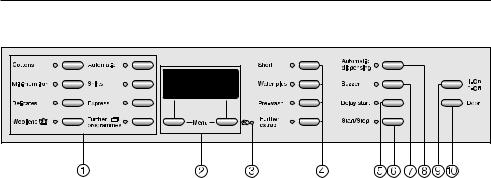
Operating the washing machine
Control panel
a Programme buttons
For selecting a washing programme.
b Display with Menu buttons
See the next pages for more information.
c PC / Optical interface
This is used by service technicians to run diagnostic checks on your machine and can also be used to update programming data in the future.
d Extra option buttons
Various extra options can be added to the washing programmes.
e Delay start button
For delaying the start time of a programme.
f Start/Stop button
For starting the programme once it is selected or calling up the Stopped: menu to cancel a programme.
g Buzzer button
An audible tone sounds at the end of the programme.
h Automatic dispensing button
Activates the automatic dispensing of liquid detergent.
i I-On/0-Off button
For switching the machine on or off.
j Door button
Opens the machine door.
10

Operating the washing machine
Display
The display is used for the following:
Selecting and displaying settings
–Temperature
–Spin speed
–Soak duration
–Delay start
–Cancelling a programme
–Safety lock
–Estimated programme duration
Selecting programmes via the display
By pressing the Further programmes button, you can select one of the following programmes:
–Denim
–Hygiene
–Dark garments
–Curtains
–Pillows
–Silks /
–Sportswear
–Outerwear
–Proofing
–Drain / Spin
–Separate rinse
–Starch
Selecting extra options via the display
By pressing the Further extras button, you can select (depending on the programme) the following extra options:
–Soak
–Rinse hold
–Extra rinse
11
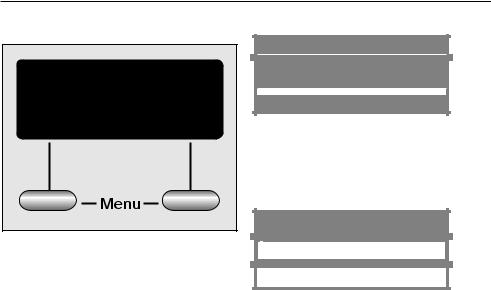
Operating the washing machine
Menu buttons
Various settings are made via the Menu buttons.
They are used to alter or confirm the value displayed above the vertical line.
To alter a setting:
Cottons
Duration: |
1:49 h |
|
|
|
|
60°C |
1600 rpm |
Pressing the left hand Menu button under 60°C alters the temperature and pressing the right hand Menu button under 1600 rpm alters the spin speed.
To confirm a setting:
Further programmes
Denim
Continue |
OK |
|
|
Pressing the left hand Menu button under Continue calls up further programmes, and you can then confirm your selection of the highlighted programme by pressing the right hand Menu button under OK.
12
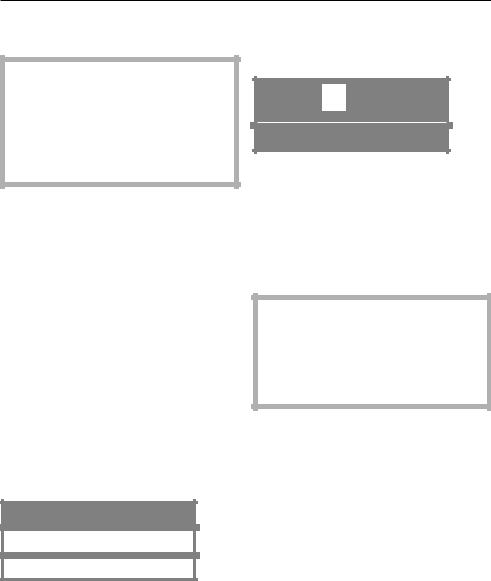
Before using for the first time
Preparing the washing machine
Before using the machine for the first time ensure that it is correctly installed and connected. See "Installation and connection". Also check that the drain filter is securely tightened to prevent the risk of water leaks during use.
^ Press the I-On/0-Off button in.
If the washing machine is being switched on for the first time, the welcome screen will appear.
The welcome screen will appear in the display every time the machine is switched on until a programme lasting longer than 1 hour has been completed.
The display for setting the language will then appear.
Setting the language
You will be asked to select the language you require for the display. It is possible to change the language at any time via the Settings menu.
Sprache
deutsch
) |
OK |
^If the language shown is not the one you want, select the language you do
want by pressing the left hand Menu button under ). Confirm your selection by pressing the right hand Menu button under OK.
Setting the time of day
The display for setting the time will then appear.
12:00
Change |
OK |
^Select the hours you want by pressing the left hand Menu button under Change, and confirm this with the right hand Menu button under
OK.
^Then set and confirm the minutes.
Reminder to remove transport struts
To avoid the risk of damage, the transport struts must be removed before the machine is used for the first time. See "Installation and connection" for instructions on how to do this.
^After removing the transport struts (if this has not already been done by your fitter) press the right hand Menu button under OK.
Reminder to remove the dispensing unit
^Open the door and remove the dispensing unit (liquid detergent container).
^Confirm that you have removed the dispensing unit by pressing the right hand Menu button under OK.
13
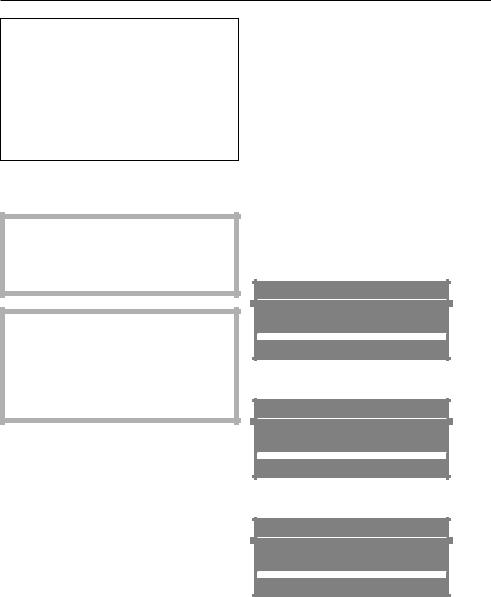
Before using for the first time
For safety reasons, spinning is not possible until the machine has been set up for using for the first time. To activate the spinning function you must run a wash programme without laundry.
This will also fill the dispensing system tube with liquid detergent.
Priming the liquid detergent dispensing system
See "Installation and connection - Dispensing unit" for instructions on how to install and connect the dispensing unit.
,The container is designed for liquid detergent only. Filling it with other agents, e.g. bleaching agents or powder detergent will damage the washing machine and/or the laundry.
Adding detergent
^Lift the container off its base, if necessary.
The container has a valve in the bottom which closes automatically when it is removed from its base.
^ Open the lid of the container.
^Add liquid detergent up to a maximum of 1 cm below the top rim (approx. 5 litres).
^Close the lid so that the liquid detergent does not dry out and to prevent any foreign objects getting into the container.
^Place the container back on its base and press it down firmly to open the valve in the bottom.
Filling the dispensing tube with detergent
^Press the Delicates programme button.
Delicates
Duration: |
0:59 h |
|
|
|
|
40°C |
600 rpm |
^ Press the left hand Menu button under 40°C.
Delicates
Duration: |
0:59 h |
|
|
|
|
30°C x |
600 rpm |
^ Press the left hand Menu button repeatedly until 60°C appears.
Delicates
Duration: |
1:19 h |
|
|
|
|
60°C |
600 rpm |
14
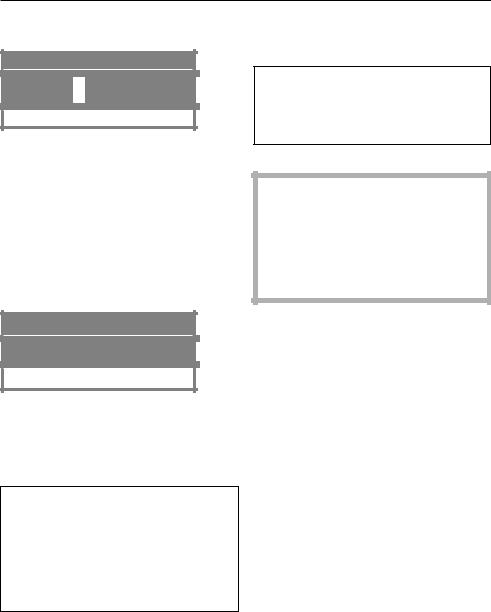
Before using for the first time
^Press the Automatic dispensing button.
Normal soiling
0 0 0 ml
* |
OK |
^Enter a dosage of 100 ml. Enter the
first number with the left hand Menu button under *. Confirm your selection of this number by pressing the right hand Menu button under OK. Now enter the second number.
^Repeat this process until all three numbers have been entered.
The display will change to show the degree of soiling.
Degree of soiling
Normal s
Continue |
OK |
^Use the left hand Menu button under Continue to select Very heavy and confirm this with the right hand Menu button under OK.
^Press the Start/Stop button.
The dosage you have set here only applies to priming the liquid detergent dispensing system. You will need to set the dosage level to that recommended by the manufacturer of the detergent you are using.
^At the end of the programme, the washing machine and dispensing system are ready for use.
There may still be air bubbles in the dispensing tube. However these will not affect the functioning of the system.
^ Switch off the washing machine.
After the washing machine and liquid detergent dispensing system have been prepared for use, you will need to set the dosage level recommended by the manufacturer of the detergent you are using, see the following page.
15

Liquid detergent dispensing
How automatic liquid detergent dispensing works
If you start a programme using automatic dispensing, the washing machine will calculate how much detergent to dispense according to the dosage level set, the amount of laundry in the drum and the degree of soiling specified. This means that the correct amount of detergent for the load will be dispensed automatically.
If the Pre-wash extra option has been selected, the washing machine will automatically divide the amount of detergent to be dispensed into the correct proportions for the pre-wash and the main wash. 1/3 will be used for the pre-wash and 2/3 for the main wash.
Dosage level
Follow the manufacturer's recommendation for normally soiled laundry given on the packaging.
The water hardness level of the local water supply must also be taken into account.
Setting the dosage level
^Close the drum door.
^Switch on the washing machine.
^Press both menu buttons at the same time until the following appears in the display:
Settings
Language F
Continue |
OK |
|
|
You are now in the Settings menu.
^Press the left hand Menu button under Continue until the Detergent dosage setting appears and confirm your selection of this by pressing the right hand Menu button under OK.
Normal soiling
1 0 0 ml
* |
OK |
^Now enter the dosage level required, e.g. for 90 ml, enter the numbers 090.
^Enter the first number with the left hand Menu button under *. Confirm your selection of this number by pressing the right hand Menu button under OK. Now enter the other numbers.
Your machine has now been set up for automatic detergent dispensing.
16
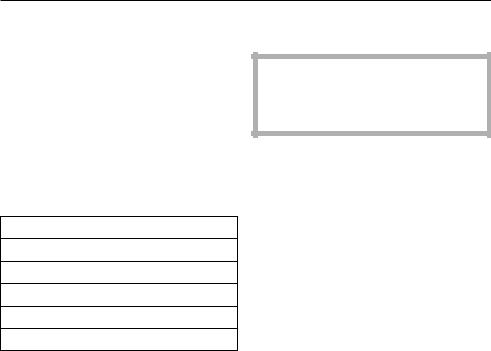
Liquid detergent dispensing
Useful tips
The correct liquid detergent
You can fill the container with any brand of liquid detergent. However, it is advisable to fill it with the brand you tend to use most frequently.
Make a note of the brand name of the liquid detergent below to remind you of the name when you need to buy some more.
Brand name
Refilling
If you want to continue using the same brand of liquid detergent, you can simply refill the container, in which case it is not necessary to clean it out.
Filling the container with a different brand
Do not mix brands of liquid detergent. This can give a poor wash result and cause the detergent to separate.
^Clean the container as described in "Cleaning and care".
^Make sure you alter the dosage level if a different dosage to the previous one set is recommended by the manufacturer.
Degrees of soiling
Light:
No visible dirt or stains. Possibly slight body odour.
Normal:
Visibly dirty and/or just a few slight stains.
Heavy:
Stains and soiling clearly visible.
Very heavy:
Stains and soiling clearly visible which have been there for a while and dried on.
17

Washing environmentally and economically
Energy and water consumption
–Water consumption and energy usage are determined by the size of the load.
To make the most out of your machine, load the maximum dry load for the programme you are using.
–Use the Automatic and Express programmes for small loads.
–When smaller amounts of laundry are washed using the Cottons programme, the automatic load recognition system will reduce the amount of water, time and energy used. This may mean that the time left shown in the display is adjusted during the course of the wash programme.
–Using the Cottons 60°C programme instead of the Cottons 95°C programme will give energy savings of between 35% and 45%. This is sufficient for most levels of soiling. For stubborn or old stains, use the Soak extra option.
Detergent
–Do not exceed the amounts of detergent recommended by the manufacturer on the packaging.
–Adjust the dosage to the degree of soiling of the laundry.
–Use Automatic dispensing.
Choosing the correct Extra option (Short, Soak, Pre-wash)
Select:
–A wash programme together with the Short extra option for light to normal soiling where there are no obvious marks.
–A wash programme without any extra options for normal to heavy soiling with visible staining.
–A wash programme together with the Soak extra option for heavily soiled laundry.
–The Pre-wash extra option for laundry with large amounts of dirt (e.g. dust, sand).
When drying with a tumble dryer
–Selecting the highest possible spin speed for the wash programme will save energy when drying in a tumble dryer afterwards.
18
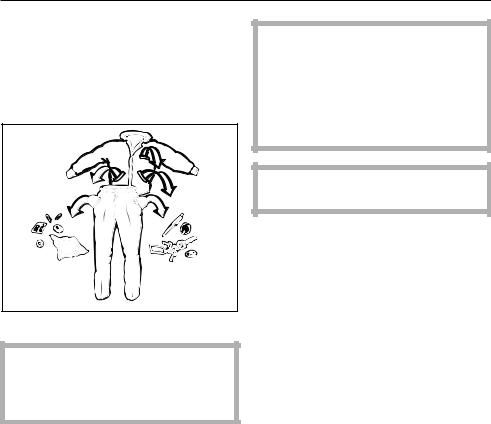
How to wash correctly
Brief instructions
The headings numbered A, B, C, . . .
show the operating sequence and can be used as brief instructions.
A Sort the laundry
^ Empty all pockets.
,Foreign objects (e.g. nails, coins, paper clips, etc.) can cause damage to garments and components in the machine.
^Badly soiled areas, stains etc. should be cleaned as soon as possible, preferably whilst still fresh. Spillages should be carefully dabbed off using a soft colourfast cloth. Do not rub!
Badly soiled areas can be pre-treated with liquid detergent, stain removers etc. first, following the manufacturer's instructions. With particularly stubborn stains ask your dry cleaner for advice.
,If you use a solvent-based cleaning agent (e.g. one containing benzene) to pre-treat a stain, make sure that any plastic parts (e.g. buttons) are protected, and that the cleaning agent is rinsed off before washing the garment in the machine.
,Do not use solvent-based cleaning agents in this machine.
^Sort the laundry by colour and by care label. Most garments have a textile care label in the collar or side seam.
Dark textiles often contain excess dye and should be washed separately several times before being included in a mixed load. Always wash whites and coloureds separately.
–Curtains: Remove lead weights first or place in a laundry bag.
–Underwiring and collar stiffeners: Any loose wiring in bras, shirt collar stiffeners, etc. should be removed or sewn in.
–Knitted garments, trousers and jeans, T-shirts and sweat shirts: Turn inside out, if recommended by the manufacturer.
–Close any zips, fasten hooks and eyes etc before washing.
–Fasten duvet covers etc. to prevent small items from being rolled up inside them.
Do not wash any items in this machine which are specified by the manufacturer as not washable on the care label. (h symbol)
19
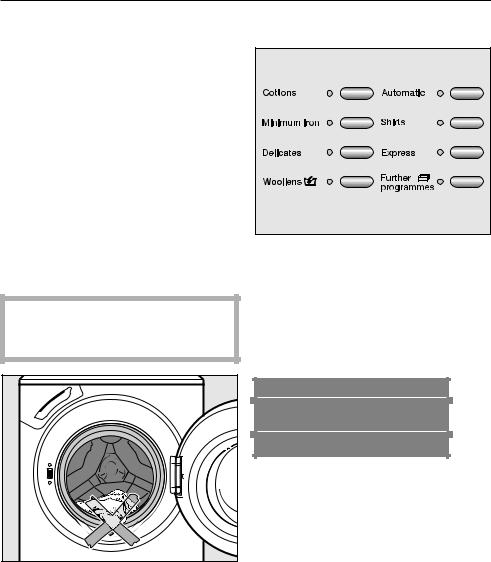
How to wash correctly
B Switch on the washing machine
The interior drum lighting will come on.
C Load the drum
^Press the Door button to open the drum door.
^Unfold the laundry and load loosely in the drum. Mixing both large and small items gives better wash results and also helps distribute the load evenly during spinning.
The most efficient use of energy and water is achieved when a full load is washed. However, do not overload as this causes creases and reduces cleaning efficiency.
Make sure that no garments are caught between the drum door and seal.
^ Shut the door with a gentle swing. |
D Select a programme
^The programmes are selected with the programme buttons.
The relevant indicator light will come on to show which programme has been selected.
The programme selected will also appear in the display.
Cottons
Duration: |
1:49 h |
60°C |
1600 rpm |
20
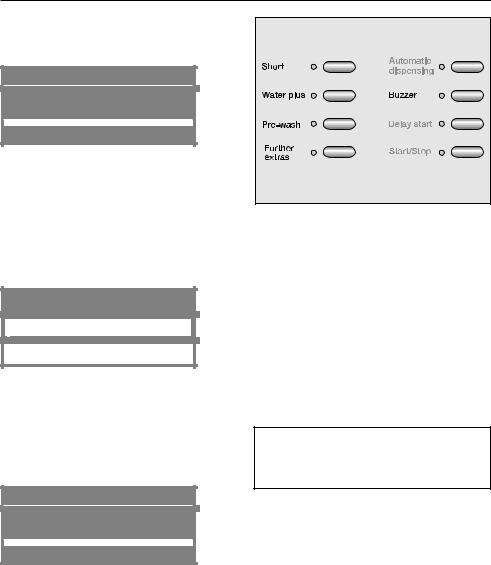
How to wash correctly
You can now set the temperature and spin speed you want via the Menu buttons.
Cottons
Duration: |
1:49 h |
|
|
|
|
60°C |
1600 rpm |
^By pressing the left hand Menu button under 60°C you can alter the temperature, and by pressing the right hand Menu button under 1600 rpm you can alter the spin speed.
Pressing the Further programmes button calls up a list of additional programmes.
Further programmes
Denim
Continue |
OK |
|
|
^Pressing the left hand Menu button under Continue calls up the further programmes, and you can then confirm your selection of the highlighted programme by pressing the right hand Menu button under
OK.
Denim
Duration: |
1:00 h |
|
|
|
|
40°C |
900 rpm |
^You can then alter the temperature and spin as described above for this programme.
^Select any extra options by pressing the appropriate button. The relevant indicator light will come on to show which extra option has been selected.
^Press the Further extras button to select the following extra options (depending on the programme selected): Soak, Rinse hold and Extra rinse.
Not all the extra options are suitable for use with every programme.
You can only select extra options which are compatible with the basic programme being used.
21
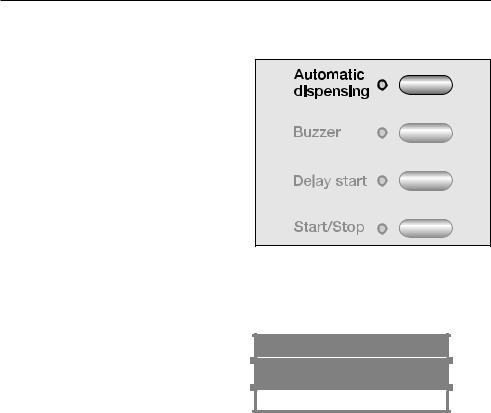
How to wash correctly
E Add detergent
Too little detergent results in:
–Laundry not getting properly clean and with time it may become grey and hard to the touch.
–Greasy particles clinging to the laundry.
–Limescale deposits on the heater elements.
Too much detergent results in:
–Excessive foam which causes a low level of agitation and poor wash, rinse and spin results.
–High water consumption (an additional rinse cycle will automatically switch in).
–A burden to the environment.
See "Detergent" for further information.
Automatic dispensing of liquid detergent
^Press the Automatic dispensing button.
The degree of soiling will appear in the display:
Degree of soiling
Normal s
Continue |
OK |
|
|
^By pressing the left hand Menu button under Continue you can alter the degree of soiling and you can confirm your selection by pressing the right hand Menu button under
OK.
Amount of liquid detergent will now be dispensed for the programme.
See "Liquid detergent dispensing" for more information.
22
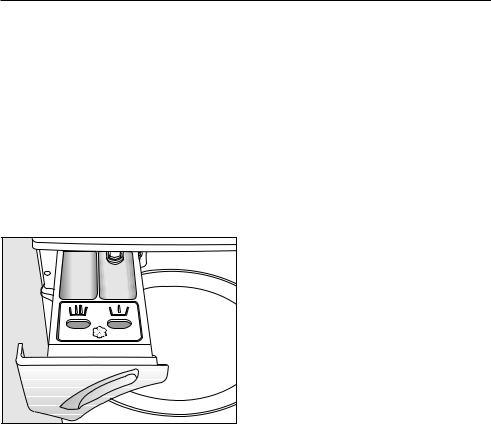
How to wash correctly
Detergent dispensing drawer
If you want to run a programme using powder detergent or special application agents, these should be added to the detergent dispensing drawer.
Please note:
–If using powder detergent or special application agents, do not press the
Automatic dispensing button, as this will cause too much detergent to be dispensed.
^Pull out the detergent drawer and add detergent to the compartments as follows:
i
Detergent for the pre-wash (divide the total recommended amount as follows: add 1/3 to compartment i and 2/3 to compartment j)
j
Detergent for the main wash, including Soak if selected
§
Fabric conditioner or liquid starch
^ Close the detergent drawer.
See "Detergent" for further information.
F Select Delay start (if required)
^Press the Delay start button to set the time you wish to programme to end at.
See "Delay start" for more information.
G Start the programme
^ Press the flashing Start/Stop button.
If a delay start time has been set, then this will count down in the display. At the end of the delay start time or immediately after the programme has started (if no delay start time has been selected) the estimated programme duration will appear in the display. During the first 8 minutes the machine measures how much water is being absorbed by the laundry. The programme duration may be longer or shorter depending on this absorbency rate.
The programme sequence is also shown in the display. The machine lets you know which section of the programme has been reached.
The drum lighting switches off once the programme has started.
23
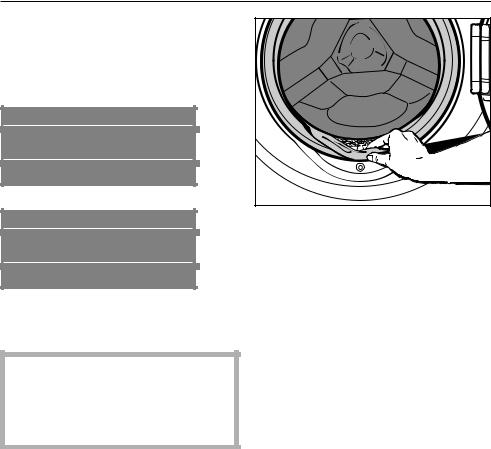
How to wash correctly
H Remove the laundry when the programme has finished
In the anti-crease phase after the programme has finished, the following will appear alternately in the display:
Cottons
Anti-crease
60°C |
1600 rpm |
and
Cottons
Finish
60°C |
1600 rpm |
^Press the Door button to open the drum door.
^Remove the laundry.
Check that all items have been removed from the drum. Items left in the drum could discolour other items in the next wash or become discoloured themselves.
^Check the folds in the door seal for any small articles, e.g. buttons, which might be lodged there.
^Switch the machine off with the I-On/ 0-Off button.
^Close the drum door. Otherwise there is the danger of objects being placed inadvertently in the drum. If these remained unnoticed and were washed in the next load, they could damage the laundry.
24
